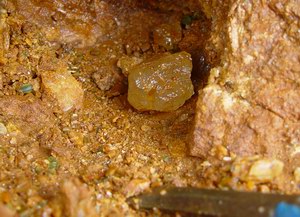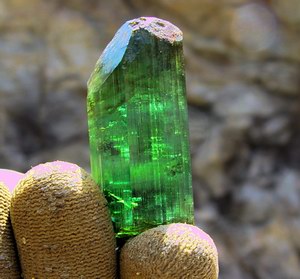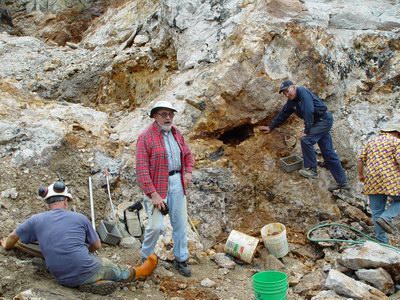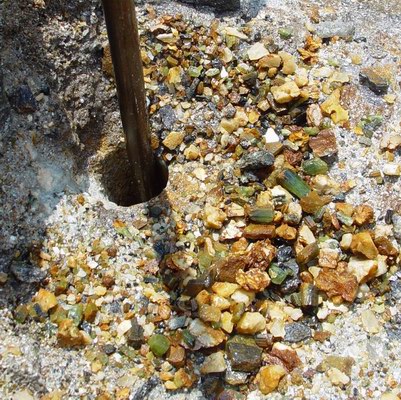
High pressure air bubbles tourmalines from a pocket (MMP8-04) 4 feet below the ledge
| After spending more than 2 weeks scratching pocket 7 (MMP7-04) down
to a Spic-N-Span shine, Richard and I were ready to open some more
ledge. Pocket 7 had become drudgery to a degree. Each day we worked it
we emerged rusty, wet and gritty. This was definitely not a
'gentleman's pocket'. Richard was always prepared in his rain
suit. I on the other hand just soaked through everyday. We knew, though,
that we were not done with 7 or what was behind it as water
continuously trickled out from the far back of the pocket. In fact,
each time the pit filled with water and we pumped it down, for hours an
appreciable flow came from the cracks at the back of 7. Something was
back there. We would have to remove more than 30 feet of schist overburden to get
there though. As we developed this part of the main pit our strategy had been to advance both an eastern face ( up strike) and a southern face ( down dip). This process of advancing upstrike required us to mine through the remnants of the huge 1979 Dagenais pocket. This pocket was more than 40' long. Unfortunately it was tourmaline poor.  Perhaps the most notable specimens to come from the Dagenais were
several large beryls. In our mining at Mt. Mica we had seen a few
beryls locked in quartz or feldspar but never a pocket beryl. So in
order to advance the eastern face, we began drilling a series of 6-
Perhaps the most notable specimens to come from the Dagenais were
several large beryls. In our mining at Mt. Mica we had seen a few
beryls locked in quartz or feldspar but never a pocket beryl. So in
order to advance the eastern face, we began drilling a series of 6-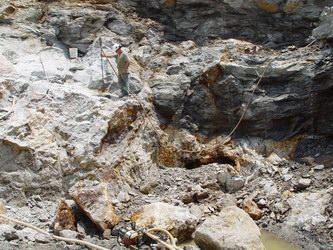 12
foot holes. As our hole pattern approached the down dip end of
the face, I drilled into a pocket at about 4 feet down. We had heard
stories, which I put off to exaggeration, of using a blowpipe to expel
tourmalines from a pocket. Here was our opportunity to test the
concept. So while I operated the air compressor, Richard probed
the
pocket with the blowpipe. To our amazement, the moment he placed the
pipe in the drill hole tourmalines and other pocket debris began
spewing out. In the picture at the right Richard probes the pocket.
Pocket 7 is visible near the center behind the muck pile. In the
next image he proudly displays some of the fruits of this
operation. This pocket received the designation 8 or
MMP8-04 ( 8th pocket at Mt Mica in 2004). 12
foot holes. As our hole pattern approached the down dip end of
the face, I drilled into a pocket at about 4 feet down. We had heard
stories, which I put off to exaggeration, of using a blowpipe to expel
tourmalines from a pocket. Here was our opportunity to test the
concept. So while I operated the air compressor, Richard probed
the
pocket with the blowpipe. To our amazement, the moment he placed the
pipe in the drill hole tourmalines and other pocket debris began
spewing out. In the picture at the right Richard probes the pocket.
Pocket 7 is visible near the center behind the muck pile. In the
next image he proudly displays some of the fruits of this
operation. This pocket received the designation 8 or
MMP8-04 ( 8th pocket at Mt Mica in 2004).The first few holes we shot were immediately down dip of the Dagenais pocket. To our surprise, just a few feet from the Dagenais, we encountered a fair sized pocket. This pocket contained 100's of small tourmalines with angle pyramidal faces on the terminations. There were a few etched beryl fragments as well. We worked this pocket until we encountered a sizable lepidolite mass in the floor which seemed to us to be the bottom of the pocket. We then decided to place some holes on either side of the pocket and shoot them quite lightly. This shot exposed even more vuggy material down dip of the first pocket. So while I worked this new vuggy material with the help of Frank Perham, Richard spent some time examining the debris of the previous pocket. Immediately he found several sizable beryl fragments. Then to everyone's amazement he pulled a well terminated complete18 cm beryl out of the muck pile. When properly illuminated the termination of this crystal is light blue. The core of the crsytal is light pink.
|
||||
| It was begining to dawn on us, however slowly, that there was a
clear pocket zone developing in a southwesterly direction down dip. We
could easily imagine a line running through the Dagenais and along its
long axis, through pockets 9 and 8 and into pocket 7. All of these
pockets were marked by a clear rusty zone. In fact the rusty material
could even be seen in the muck pile running updip in front of the
Dagenais. Extending this line further updip, its path traversed
somewhere near the general area believed to be the site of original
Hamlin and Holmes discovery in 1820(21). |
